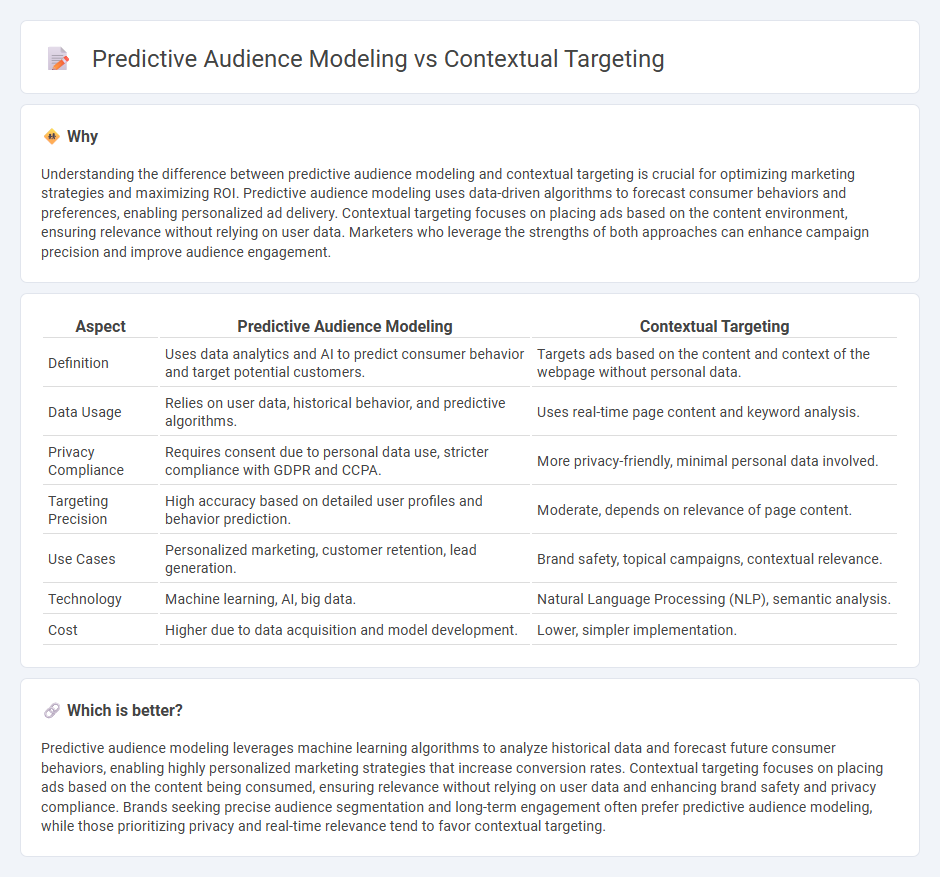
Predictive audience modeling leverages advanced data analytics and machine learning algorithms to anticipate consumer behavior and preferences, enabling highly personalized marketing campaigns. Contextual targeting focuses on delivering ads based on the content of the environment where the ad appears, ensuring relevance without relying on user data. Explore how these approaches can transform your marketing strategy by combining precision with privacy.
Why it is important
Understanding the difference between predictive audience modeling and contextual targeting is crucial for optimizing marketing strategies and maximizing ROI. Predictive audience modeling uses data-driven algorithms to forecast consumer behaviors and preferences, enabling personalized ad delivery. Contextual targeting focuses on placing ads based on the content environment, ensuring relevance without relying on user data. Marketers who leverage the strengths of both approaches can enhance campaign precision and improve audience engagement.
Comparison Table
| Aspect | Predictive Audience Modeling | Contextual Targeting |
|---|---|---|
| Definition | Uses data analytics and AI to predict consumer behavior and target potential customers. | Targets ads based on the content and context of the webpage without personal data. |
| Data Usage | Relies on user data, historical behavior, and predictive algorithms. | Uses real-time page content and keyword analysis. |
| Privacy Compliance | Requires consent due to personal data use, stricter compliance with GDPR and CCPA. | More privacy-friendly, minimal personal data involved. |
| Targeting Precision | High accuracy based on detailed user profiles and behavior prediction. | Moderate, depends on relevance of page content. |
| Use Cases | Personalized marketing, customer retention, lead generation. | Brand safety, topical campaigns, contextual relevance. |
| Technology | Machine learning, AI, big data. | Natural Language Processing (NLP), semantic analysis. |
| Cost | Higher due to data acquisition and model development. | Lower, simpler implementation. |
Which is better?
Predictive audience modeling leverages machine learning algorithms to analyze historical data and forecast future consumer behaviors, enabling highly personalized marketing strategies that increase conversion rates. Contextual targeting focuses on placing ads based on the content being consumed, ensuring relevance without relying on user data and enhancing brand safety and privacy compliance. Brands seeking precise audience segmentation and long-term engagement often prefer predictive audience modeling, while those prioritizing privacy and real-time relevance tend to favor contextual targeting.
Connection
Predictive audience modeling leverages data analytics and machine learning algorithms to forecast consumer behavior, enabling marketers to segment audiences with high precision. Contextual targeting uses this insight to deliver relevant advertisements based on real-time content and user context, ensuring ads resonate with current consumer interests. The synergy between these techniques enhances campaign effectiveness by combining behavioral predictions with situational relevance.
Key Terms
Keywords (Contextual Targeting)
Contextual targeting leverages real-time analysis of keywords and content themes to deliver ads relevant to the surrounding environment, enhancing ad engagement and user experience. By matching ads with contextually appropriate keywords, this method increases relevance without relying on user data, ensuring privacy compliance and precise targeting. Explore the benefits and techniques of keyword-focused contextual targeting for more effective advertising strategies.
Machine Learning (Predictive Audience Modeling)
Machine learning in predictive audience modeling uses historical data and behavioral patterns to forecast future consumer actions, enhancing ad relevance and campaign efficiency. This approach contrasts with contextual targeting, which relies on real-time content analysis to match ads with the current page topic. Explore how machine learning transforms audience insights for more precise marketing strategies.
Real-time Data (Predictive Audience Modeling)
Real-time data enhances predictive audience modeling by analyzing current user behaviors and interactions to forecast future engagement with high precision. This dynamic approach outperforms contextual targeting, which relies on static page content, by continuously updating audience segments based on live data signals such as browsing patterns, purchase intent, and social activity. Explore how leveraging real-time data in predictive audience modeling can maximize campaign effectiveness and ROI.
Source and External Links
What is Contextual Advertising? Why is it Important? - Amazon Ads - Contextual targeting displays ads based on the real-time content of the current webpage, ensuring relevance by analyzing text, images, and media to match ads with appropriate themes and subjects.
Contextual Advertising: What it is, how it works, and why to use it - Advertisers use contextual targeting by selecting parameters like keywords, topics, negative keywords, location, and language to place ads on webpages that match their campaign's context, allowing for precise or broad reach depending on goals.
What is Contextual Targeting? - Integral Ad Science - Contextual targeting enables advertisers to reach audiences based on specific interests, events, or topics without relying on user data, using advanced AI and NLP to classify content for privacy-safe, relevant ad placements.
 dowidth.com
dowidth.com